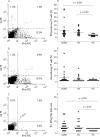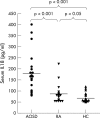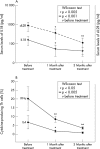Predominance of Th1 cytokine in peripheral blood and pathological tissues of patients with active untreated adult onset Still's disease
- PMID: 15361391
- PMCID: PMC1754751
- DOI: 10.1136/ard.2003.013680
Predominance of Th1 cytokine in peripheral blood and pathological tissues of patients with active untreated adult onset Still's disease
Abstract
Objective: To determine the type 1 T helper (Th1)/type 2 T helper (Th2) balance in the peripheral blood (PB) and pathological tissues of patients with active untreated adult onset Still's disease (AOSD).
Methods: The percentages of interferon gamma (IFNgamma)- and interleukin (IL)4-producing Th cells in the PB of 20 patients with active untreated AOSD, 20 patients with active rheumatoid arthritis (RA), and 20 healthy controls were determined by intracellular staining and flow cytometry. Serum levels of IL18 and soluble IL2 receptor were measured by enzyme linked immunosorbent assay. Levels of IFNgamma and IL4 messenger (m) RNA expression were examined by real time quantitative polymerase chain reaction in biopsy specimens of evanescent rash and synovitis from 8 patients with AOSD.
Results: Significantly higher IFNgamma-producing Th cells and Th1/Th2 ratio in PB were found in patients with AOSD than in healthy controls. Percentages of IFNgamma-producing Th cells and Th1/Th2 ratio in PB correlated significantly with clinical activity score and serum IL18 levels in patients with AOSD. Increased ratio of Th1/Th2 cytokine transcripts was seen in the biopsy specimens of evanescent rash and synovitis from patients with AOSD compared with normal skin controls and patients with OA. Th cell cytokine pattern in PB and cytokine mRNA expression in synovium were similar for patients with AOSD and with RA. After 3 months' treatment, clinical remission was associated with a marked decrease in the percentages of cytokine-producing Th1 cells, but not of the Th2 cells.
Conclusion: A predominance of Th1 cytokine may precipitate the pathogenesis of AOSD.
Figures




References
Publication types
MeSH terms
Substances
LinkOut - more resources
Full Text Sources
Other Literature Sources
Miscellaneous

